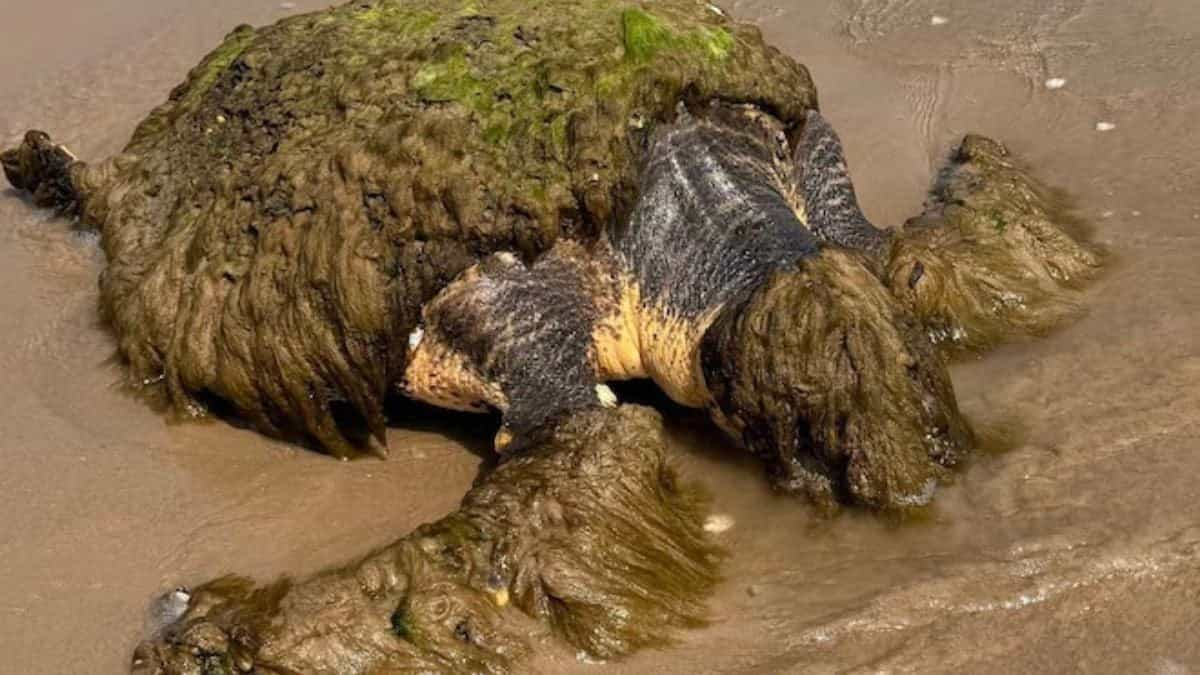Show table of content Hide table of content
On a seemingly ordinary day at Sargent Beach in Texas, visitors stumbled upon what would become an extraordinary rescue mission. A family enjoying their coastal stroll discovered a mysterious creature struggling at the shoreline. What they initially mistook for ocean debris turned out to be a living animal fighting for survival in the Matagorda Bay area of the Gulf of Mexico.
Strange creature discovered washed ashore in Texas
Last week, beachgoers in Sargent, Texas, experienced an unexpected encounter with marine wildlife. What appeared from a distance as an unusual shape moving along the shoreline quickly became the focus of a critical rescue operation. The family approached cautiously, curiosity guiding their steps toward the mysterious form.
“At first, we thought it was just trash washing up with the tide,” one witness recounted. “But then we noticed it was moving slightly despite being covered in strange growths.”
Upon closer inspection, they made a shocking discovery – a loggerhead sea turtle in dire condition. The reptile was barely moving, its body encrusted with barnacles and other marine organisms that had attached themselves to its shell, flippers, and even its face. These parasitic hitchhikers had severely compromised the turtle’s health and mobility.
The unexpected sight of this struggling creature resonated with the family, who displayed remarkable composure in a situation where many might panic. Animal rescues often require quick thinking, similar to cases where a mother dog protects her puppies in dangerous situations until rescue arrives, showing how critical timely intervention can be for animals in distress.
Life-saving intervention by quick-thinking visitors
Recognizing the turtle’s critical condition, the family took immediate action that would ultimately save its life. Rather than attempting to handle the marine animal themselves – which could potentially cause more harm – they contacted local wildlife experts specialized in sea turtle conservation.
The Gulf Center for Sea Turtle Research (GCSTR) quickly dispatched a team to the location. Upon arrival, specialists provided emergency care right on the beach before carefully transporting the loggerhead to a specialized marine animal clinic for comprehensive treatment.
Animals A female sea lion refuses to mate with a male, causing a fight and the closure of the zoo.
“The turtle was significantly weighed down by barnacles deeply embedded in its soft tissues and mouth,” explained a GCSTR representative. “This is unfortunately common in our waters, but this case was particularly severe.”
This rescue mirrors other heartwarming wildlife interventions, such as when rescuers found a dog alone in the woods making a bed out of pine needles – both stories highlight how human compassion can make a profound difference for animals struggling in challenging environments.
Marine parasites: hidden threat to sea turtles
The condition afflicting this loggerhead turtle is more common than many realize along the Texas coastline. Cirripedes, a type of crustacean that includes barnacles, naturally attach themselves to various surfaces in marine environments – including living creatures like sea turtles.
Under normal circumstances, healthy turtles can manage with a few hitchhikers. However, when a turtle becomes weakened due to injury, illness, or environmental stressors, these organisms can proliferate unchecked. As barnacles multiply across the turtle’s body, they create drag when swimming, making it increasingly difficult for the animal to hunt, evade predators, or surface for breath.
Animals A hammerhead shark crashes down from the sky in South Carolina, halting a disc golf game.
The relationship between marine creatures can be complex, ranging from harmful parasitic attachments to surprising benevolent connections. Scientists continue studying these interactions, similar to how researchers explore unexpected animal relationships like when a squirrel visits a Golden Retriever daily, developing an unusual trust, demonstrating nature’s capacity for surprising intersections.
In recent months, marine biologists have noted increased instances of parasitic infestations among sea turtles in the Gulf of Mexico. This trend has caught the attention of researchers who recently discovered a new predatory creature at extreme ocean depths, highlighting how marine ecosystems continue to reveal new information about delicate ecological balances.
Recovery journey and hope for return to the wild
Since the rescue, GCSTR specialists have provided intensive care to the loggerhead turtle. The treatment protocol included carefully removing the barnacles, administering antibiotics to prevent infection, and providing nutritional support. Their dedication has paid off significantly.
“She’s doing much better now,” shared the GCSTR team in a recent update. “She’s eating consistently and gaining weight. The recovery process from such heavy barnacle infestation takes time, but we’re seeing promising progress.”
Animals A wild elephant enters a convenience store and raids the food aisle.
The rehabilitation of wild animals often requires patience and specialized care. Whether it’s a sea turtle encrusted with barnacles or a blind senior dog learning to trust again after abandonment, these stories remind us of the resilience found throughout the animal kingdom.
Staff members monitor the turtle daily, tracking its recovery with cautious optimism. If progress continues at the current rate, experts believe the loggerhead could potentially return to its natural habitat within weeks. Before release, the turtle will undergo final health assessments to ensure it can thrive independently in the wild.
The successful rehabilitation brings joy not only to the rescue team but also to the family who first spotted the creature. Their quick response created a chain of compassionate action that saved a life – resembling the devotion seen when dogs find heartwarming ways to welcome their owners home, showing how connections between humans and animals continue to inspire.
For the GCSTR, this rescue represents another chapter in their ongoing mission to protect the Gulf’s marine turtle populations, reinforcing the importance of public awareness and prompt reporting when encountering wildlife in distress along coastlines.


